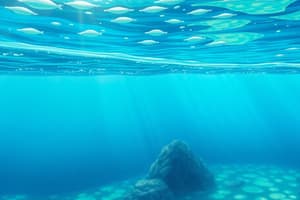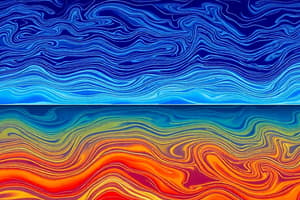Podcast
Questions and Answers
What is thermohaline circulation primarily driven by?
What is thermohaline circulation primarily driven by?
- Differences in water density due to temperature and salinity (correct)
- Solar radiation heating the water
- The gravitational pull of the Moon
- Wind patterns across the ocean surface
At what depth does a wave typically begin to feel the bottom?
At what depth does a wave typically begin to feel the bottom?
- The full wavelength
- Two wavelengths
- One-fourth of its wavelength (correct)
- Half of its wavelength
Which pair of Moon phases is associated with spring tides?
Which pair of Moon phases is associated with spring tides?
- New Moon and Full Moon (correct)
- Waxing gibbous and waning crescent
- Waxing crescent and waning gibbous
- First quarter and third quarter
Which of the following shoreline features is a result of wave erosion?
Which of the following shoreline features is a result of wave erosion?
What are the components of a wave commonly classified as?
What are the components of a wave commonly classified as?
Flashcards are hidden until you start studying
Study Notes
Thermohaline Circulation
- Driven by variations in water density, influenced by temperature (thermo) and salinity (haline)
- Warm, less salty surface water flows towards the poles
- Water cools and becomes saltier, increasing density, leading to sinking
- Cold, dense water flows along the ocean floor towards the equator
- This deep flow eventually upwells, bringing nutrients and contributing to surface current patterns
Global Water Movements
- Surface currents driven by wind patterns
- Deep ocean currents driven by density differences
- These combined currents form a global network of circulating water
- Surface currents transport heat, influencing regional climates
- Deep currents play a crucial role in nutrient distribution and oxygenation
Shoreline Features
Wave Erosion
- Wave-cut platform: a flat, rocky surface created by wave erosion at the base of a cliff
- Cliffs: steep, vertical rock faces formed by wave erosion
- Terraces: step-like platforms created by wave erosion and uplift
- Sea arches: natural archways formed by wave erosion through headlands
- Sea stacks: isolated rock formations left behind after wave erosion of headlands
Sediment Deposition
- Spits: narrow sand deposits extending from the coastline
- Bars: submerged or exposed sand deposits parallel to the coast
- Tombolos: sand deposits connecting an island to the mainland
- Barrier Islands: long, narrow islands separated from the mainland by lagoons
Wave Structure
- Crest: highest point of a wave
- Trough: lowest point of a wave
- Wavelength: distance between two successive crests or troughs
- Wave height: vertical distance between the crest and trough
- Wave period: time it takes for one complete wave cycle to pass a given point
Wave Interaction with the Seafloor
- Wave "feels bottom" when depth is less than half the wavelength
- Wave breaks when the depth is about 1.3 times the wave height
Tides
- Regular rise and fall of sea level caused by gravitational pull of the Moon and Sun
- Moon's gravitational pull is stronger than the Sun's due to its proximity to Earth
Spring Tides
- Earth, Moon, and Sun aligned (new moon or full moon)
- Strongest gravitational pull
- Highest high tides and lowest low tides
Neap Tides
- Earth, Moon, and Sun at 90° angles (first or third quarter moon)
- Weaker gravitational pull
- Lower high tides and higher low tides
Tidal Patterns
- Diurnal: One high and one low tide each day
- Semidiurnal: Two high and two low tides each day
- Mixed: Two high tides and two low tides each day, with unequal heights
Studying That Suits You
Use AI to generate personalized quizzes and flashcards to suit your learning preferences.





